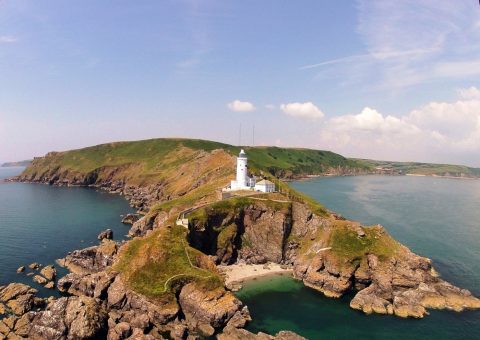Lighthouses are fascinating. They are romantically beautiful, symbolise vastness and freedom, are landmarks for ships, provide orientation and are leading the way. If you want to “dream yourself away” from the current situation, you can easily find this on England’s coast and can plan interesting walks, often from tower to tower.
“More than 60 lighthouses are dotted around the breathtaking and varied English coastline and many are open to the public,” says Samantha Richardson, Director of the National Coastal Tourism Academy and the “England’s Coast” project. “The towers are off the beaten track and make wonderful photo stops or even overnight stays – far away from the hustle and bustle of everyday life and in the midst of fantastically lonely coastal landscapes. So when restrictions permit, they turn a coastal trip into a magical visit” says Richardson. England’s Coast, an alliance of all eight coastal regions, is using the project to mark their culture, legendary history and picturesque coastal landscapes.
Flamborough Head, a peninsula between the bays of Filey and Bridlington in the county of Yorkshire, is home to two lighthouses. The listed chalk tower from 1669 is one of the oldest completely preserved lighthouses in England. Not far from it, a second lighthouse was built in 1806. More than 200,000 seabirds, including gannets and puffins, nest on the protected cliffs around the towers.
The oldest lighthouse in England and one of the oldest worldwide stands in the grounds of Dover Castle. The tower was built by the Romans around 43 AD as a navigational aid for crossing the Channel. The well-preserved ruin is a beautiful photo spot and stands right next to the small church of St. Mary-in-Castro from 1020 AD.
East of Dover, the South Foreland Lighthouse at St Margaret’s at Cliffe towers high above the famous “White Cliffs of Dover”. The Victorian tower warns of the dangerous Goodwin Sands, which were already mentioned in William Shakespeare’s play “The Merchant of Venice” and which were the tragic doom of over 2,000 ships. From Mrs Knott’s tearoom, furnished in 1950s style and named after the wife of the former lighthouse keeper, you have a fabulous view of the world’s busiest shipping lane while enjoying delicious cream tea.
In East Sussex, the Belle Tout Lighthouse (1832), overlooking the English Channel, did not always stand on its present site. In 1999, it was moved a full 17 m north to prevent erosion of the chalk cliffs from causing it to fall into the sea.
As the Belle Tout fire was difficult to see when the clouds were low, a new tower was built in 1902 directly into the sea in front of the 162-metre steep white cliffs. The clearly visible red-and-white-striped Beachy Head Lighthouse in such an exposed position is often used as a film set or for advertising photos. The location is historically interesting, and rumors say it is haunted.
The High Cliffs on the North Yorkshire coast are a particularly pretty spot. Captain James Cook was apprenticed to a shipowner in Whitby and set out from here on his first voyage of discovery (1768-1771). You can spend the night in the modern and comfortably furnished Vanguard holiday home high above the coast directly at Whitby Lighthouse, which is ideal for extended walking tours in the North York Moors.
Probably the best-known lighthouse is the Eddystone Lighthouse off Plymouth, Devon. There has been a lighthouse at this site since 1698. A forerunner of today’s fourth tower is mentioned in the novel Moby Dick.
Further information on the lighthouses at:
www.englandscoast.com/de
www.trinityhouse.co.uk/lighthouses-and-lightvessels
England’s Coast advises visitors to adhere to local travel restrictions and regional tiers, which can be found on the Gov UK website: https://www.gov.uk/guidance/full-list-of-local-restriction-tiers-by-area.
Notes to editors:
The England’s Coast project is delivered by the National Coastal Tourism Academy whose partners include: The Yorkshire Coast, Visit Scarborough, The North York Moors National Park Authority, Visit East Yorkshire, Visit Lancashire, Visit Cumbria, This is Durham, Visit Northumberland, Visit Essex, Visit Thanet, Dover/White Cliffs Country, Creative Coast Kent, Visit Brighton, Experience West Sussex, Visit Portsmouth, Discover Gosport, Visit Isle of Wight, Coast with the Most -Bournemouth/Christchurch/Poole, Somerset and Exmoor National Park – The Hinkley Tourism Action Partnership, P&O Ferries, Hornblower City Cruises Poole.
About the Discover England Fund:
In November 2015, the Government announced a £40 million Discover England Fund; an unprecedented opportunity for English tourism. The Fund aims to deliver world-class bookable tourism products joined up across geographies and/or themes; including integrated transport solutions to provide an end-to-end customer experience. The Fund supports the growth of one of England’s most successful export industries, inbound tourism. Tourism is an industry that delivers jobs and economic growth across the English regions – contributing some £106bn each year to the economy and supporting 2.6 million jobs. The Fund supported a number of pilot projects in year one (2016/17) that tested product development approaches. In years two and three, 2017-19, the fund supported a number of large-scale collaborative projects to be delivered over the two-year period 2017-2019 that will create a step-change in bookable English tourism product for international consumers, a smaller funding pot for new one-year pilot projects (in year two), and continuation funding for existing year one projects that demonstrated early learnings (in year two). In Year four (2019/20) an extended period was granted for delivery of the large-scale projects to ensure delivery and/or amplification. In year five (2020/21) additional funding allocated by HM Treasury includes grant funding to existing projects, marketing and distribution activity led by VisitBritain/VisitEngland and evaluation and research.


